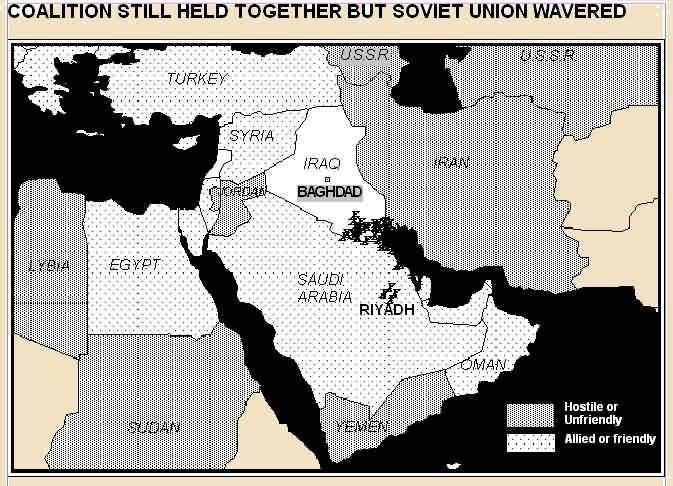Home | Back to TWR Index | Email | The Editor | History | Gulf War Index
In this issue: A Gulf War Chronology & Saddam
Retreats

![]()
Volume 5, Number 9 February 27, 1991
|
Comprehensive Gulf War Chronology Aug. 2 — Iraq's army invaded Kuwait following Iraqi grievances over oil pricing, Kuwaiti loans to Iraq, and Iraqi claims on Kuwaiti territory. — U.N. Resolution 660 determined that a breach of international peace and security had taken place (ie. that it was a legitimate issue for the Security Council); condemned the Iraqi invasion; demanded that Iraq withdraw from Kuwait; and called upon Iraq and Kuwait to negotiate. Aug. 3 — The United States announced that it would be sending naval forces to the Persian Gulf region. Aug. 6 — U.N. Resolution 661 determined that Iraq had not complied with 660; affirmed the right of individual or collective self-defence; under U.N. Charter Chapter 7 called upon all states to impose strict economic sanctions on Iraq until it complied with 660 "but not including supplies intended strictly for medical purposes, and, in humanitarian circumstances, foodstuffs"; set up the `661 Committee' (U.N.S.C. members) to gather information and advise on sanctions. Aug. 7 — Bush orders deployment of U.S. troops to the Gulf region. Aug. 9 — U.N. Resolution 662 decided that the annexation of Kuwait by Iraq is null and void and demanded that Iraq rescind its declaration of annexation.
|
Aug. 10
— Prime Minister Brian Mulroney declares that "Iraq, a U.N. member country, has violated the United Nations Charter and brutally attacked, without provocation, its smaller neighbour Kuwait."
— The PM announced that Canada "has suspended trade and economic relations with Iraq," and that he had decided to dispatch three ships to the Persian Gulf.
— The Athabaskan, the Terra Nova and the Protecteur, with a complement of 800 crew members, will join with naval vessels from Saudi Arabia, the United States, the United Kingdom, France, Australia and the Soviet Union and other countries already operating in, or destined for that region. Vice Chief of the Defence Staff, Vice-Admiral Chuck Thomas names the task group "Operation Friction".
Aug. 17
— Saddam Hussein threatens to use Western civilian hostages, including Canadians, as human shields against coalition force attacks.
Aug. 18
— U.N. Resolution 664 demanded Iraq permit immediate departure from Kuwait and Iraq of third-country nationals and that Iraq take no action to jeopardize the safety, security or health of such nationals; demanded that Iraq rescind orders for the closure of diplomatic missions in Kuwait.
Aug. 25
— U.N. Resolution 665 called upon states deploying maritime forces to use such measures as may be necessary to halt all maritime shipping in order to inspect cargo and ensure strict implementation of U.N. Resolution 661; coordinate actions using "as appropriate" the Military Staff Committee.
Aug. 28
— Iraq declared Kuwait to be its 19th province.
Sept. 9
— The Bush/Gorbachev Helsinki Summit condemns the invasion of Kuwait and urges Saddam Hussein to withdraw his troops.
-
Publisher and Editor In Chief: Micheal J. O'Brien
-
Circulation Manager: Julie K. Kwiecinski
-
Editorial Staff Writer:
-
Frederick J. Harris
-
Contributing Editors:
-
Dale Grant (Toronto)
-
Patrick McManus (Halifax)
-
William Kane (Washington DC)
-
John Reed (London, England)
-
Moshe Karem (Jerusalem, Israel)
-
The Wednesday Report is published weekly by
-
MPRM Group Limited, 27 Yonge Street South, Aurora, Ontario, Canada L4G 1L8. Telephone: (416) 841-1277 Facsimile/Data: (416) 841-4389.
-
Subscription Rates: first class mail delivery $500 yearly, express delivery $650 yearly, single copy $15.
-
ISSN 0835-6122
-
Copyright: ©MPRM Group Limited 1991.
-
All rights reserved. Reproduction in part or in whole,
-
in any manner whatsoever, is strictly forbidden.
